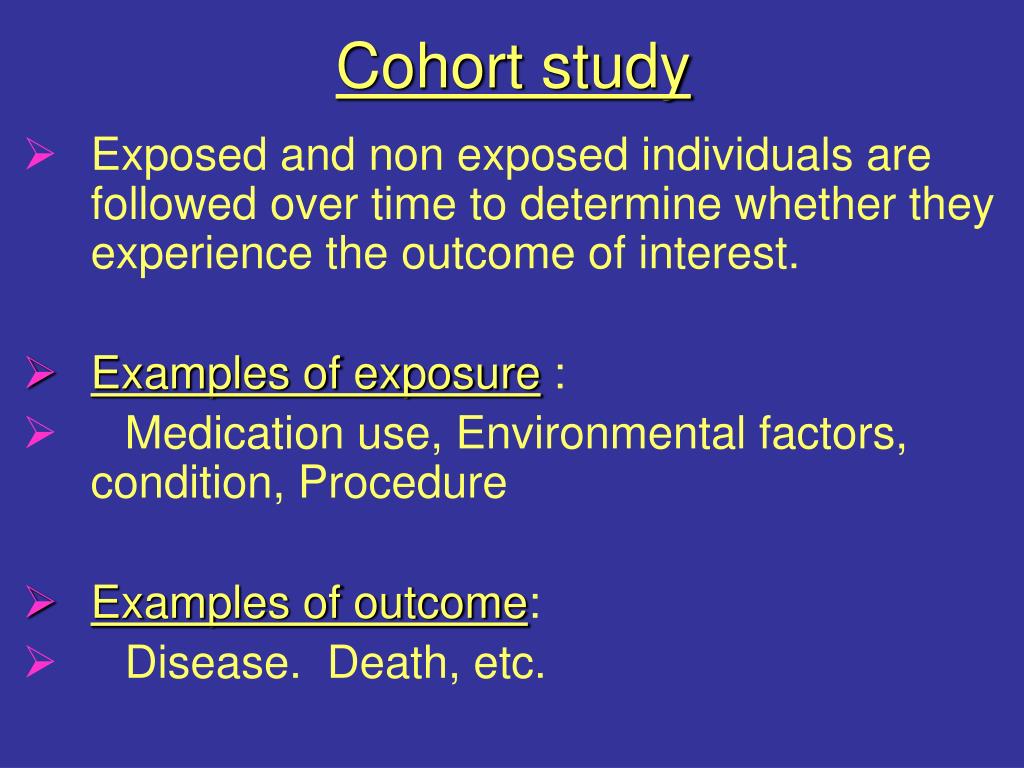
Explain the factors that should be considered in selecting subjects for a cohort study. Explain the advantages and disadvantages of the cohort design in general and the strengths and weaknesses of retrospective and prospective cohort studies. Distinguish between "closed" and "open" cohorts. Define what a cohort study is and explain its key features. Upon successful completion of this section of the course, the student will be able to: It must be established that a cohort did not have the outcome of interest at the beginning of the observation period, and the cohort needs to be examined again to determine whether or not the outcome subsequently developed, i.e., the incidence in each of the exposure groups. (We can refer to the groups being compared as exposure cohorts.) Cohorts may be identified retrospectively or prospectively, but in either case the outcome status needs to be established at least twice. The study is coordinated by Carla Haelermans.The characteristic feature of a cohort study is that the investigator identifies subjects at a point in time when they do not have the outcome of interest and compares the incidence of the outcome of interest among groups of exposed and unexposed (or less exposed) subjects. Most schools use a national standardized test for this, which makes it possible to have information on the development of students’ performance between the age of 8 and 12.īased on these data, annually 10.000 confidential school reports are produced for every school in primary and secondary education to inform school boards, school leaders, teachers, and quality control staff about the performance of students in their school as well as the outcomes after they leave school. Primary schools in the Netherlands are required to monitor their students’ progress in domains such as reading, spelling and maths. In the future this data will be complemented with more detailed information on the educational process and school quality.Ī third pillar consists of microdata on student performance from school administrative systems. school size, the level of urbanization of the location of the school and its (religious/secular) denomination. This information is available through the Dutch Ministry of Education and the Dutch Inspectorate of Education. The second pillar consists of additional information at the school level. The NCO data set therefore also holds information on whether or not and to what extent a school population consists of students with disadvantageous socioeconomic status. The funding of Dutch primary schools is partly based on the socioeconomic background of the school’s population. Parental variables include variables on their highest obtained educational level, SES, working status, income, and wealth. For each student, information on age, gender, country of origin, marital status of the parents, household information, socioeconomic status (SES) of both student and his/her parents, and regional variables are available. The first pillar maps students’ pathways through education and their trajectory into tertiary education and combines this with very rich and extensive information on their (social and family) background using register data from Statistics Netherlands. 
The Netherlands Cohort Study on Education currently consists of three pillars. This study is instigated and financed by the Netherlands Organization for Scientific Research (NWO), specifically by the Netherlands Initiative for Education Research (NRO).The dataset is based at Statistics Netherlands, where it is combined with school administrative data on students’ performance, such as the standardized tests scores used in our study. The Netherlands Cohort Study on Education (Dutch abbreviation: ‘NCO’) uses longitudinal register data on track placement of cohorts of students in primary and secondary education.

Research team: Henry Abbink, Sabine Baumann, Willemijn Havermans, Stef Hendrickx, Arnold Hendrikse, Timo Huijgen, Madelon Jacobs, Roy Meijer, Mélanie Monfrance, Chayenne Smeets, Lynn van Vugt, Sanne van Wetten






 0 kommentar(er)
0 kommentar(er)
